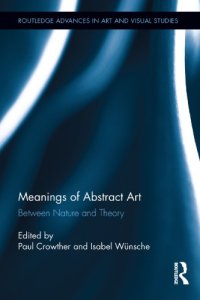
Ebook: Meanings of Abstract Art: Between Nature and Theory
Author: Paul Crowther Isabel Wünsche
- Tags: Criticism History Arts Photography Reference Almanacs Yearbooks Atlases Maps Careers Catalogs Directories Consumer Guides Dictionaries Thesauruses Encyclopedias Subject English as a Second Language Etiquette Foreign Study Genealogy Quotations Survival Emergency Preparedness Test Preparation Words Grammar Writing Research Publishing Communication Media Studies Social Sciences Politics Art Humanities New Used Rental Textbooks Specialty Boutique Anthropology Archaeology Criminology Gay Lesbian Gend
- Series: Routledge Advances in Art and Visual Studies
- Year: 2012
- Publisher: Routledge
- Edition: 1
- Language: English
- pdf
Traditional art is based on conventions of resemblance between the work and that which it is a representation "of". Abstract art, in contrast, either adopts alternative modes of visual representation or reconfigures mimetic convention. This book explores the relation of abstract art to nature (taking nature in the broadest sense―the world of recognisable objects, creatures, organisms, processes, and states of affairs).
Abstract art takes many different forms, but there are shared key structural features centered on two basic relations to nature. The first abstracts from nature, to give selected aspects of it a new and extremely unfamiliar appearance. The second affirms a natural creativity that issues in new, autonomous forms that are not constrained by mimetic conventions. (Such creativity is often attributed to the power of the unconscious.)
The book covers three categories: classical modernism (Mondrian, Malevich, Kandinsky, Arp, early American abstraction); post-war abstraction (Pollock, Still, Newman, Smithson, Noguchi, Arte Povera, Michaux, postmodern developments); and the broader historical and philosophical scope.